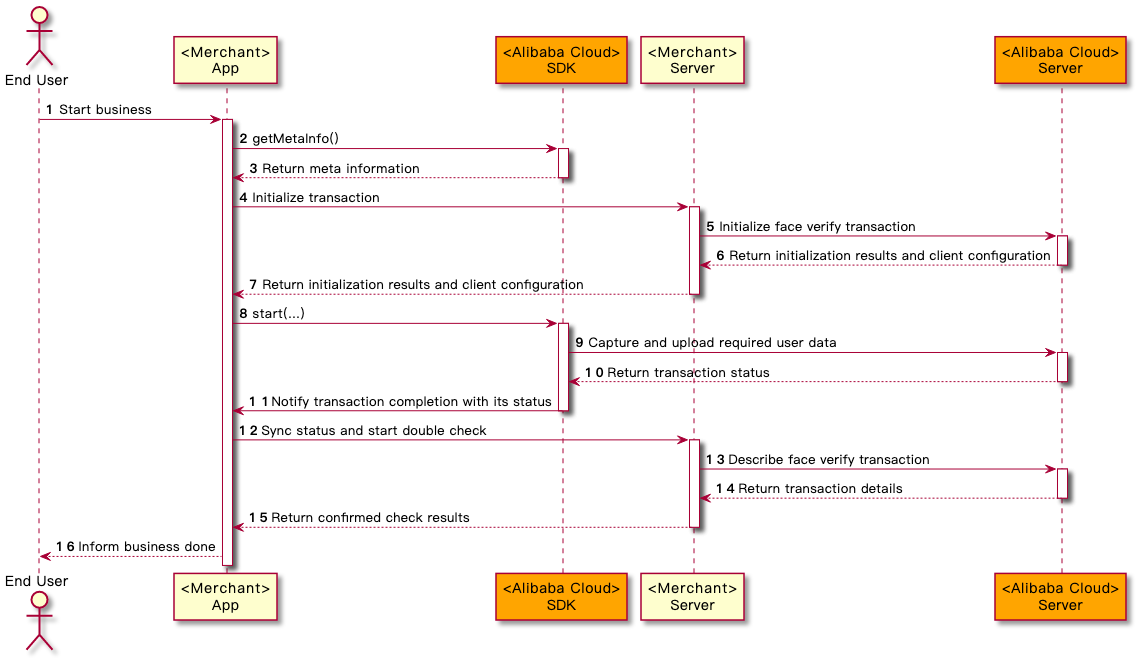You can use the client SDK plus server-side API operations to integrate ID Verification with your app only when the required app is available and you want the app to verify users online.
Prerequisites
You must understand how to construct a request signature when you call an ID Verification operation by sending an HTTP or HTTPS request.
For more information about the data signing methods, see API signature methods.
Procedure
Activate ID Verification. For more information, see Activate ID Verification - KYC.
Integrate ID Verification with your app.
To use the wireless SDK plus server-side integration method to integrate ID Verification with your app, perform the following steps:
Call the Initialize operation on the server.
Call the SDK on the client with which you want to integrate ID Verification.
Call the query operation on the server.
The following figure shows the details of the procedure.

Step
Description
1
A user initiates a business process (for example, an identity proofing process) through the merchant application.
2
The merchant app calls the getMetaInfo interface to obtain the meta information about the Alibaba Cloud SDK and the user's device for preparation.
3
The Alibaba Cloud SDK returns the meta information to the merchant application.
4
The merchant application initializes a transaction and passes the meta information to the merchant server.
5
With the meta information as an input, the merchant server calls Initialize API to obtain the client configuration information, which includes parameters about SDK connection and behavior.
6
The Alibaba Cloud server performs usability check based on the meta information. If the check is passed, the Alibaba Cloud server returns the client configuration information to the merchant server.
7
The merchant server returns the client configuration information to the merchant application.
8
The merchant application starts the Alibaba Cloud SDK with the client configuration information that is obtained in Step 7.
9
The Alibaba Cloud SDK interacts with the user, captures required data (for example, face images) and uploads it to the Alibaba Cloud server for verification. There might be multiple rounds of interaction between the Alibaba Cloud SDK and Alibaba Cloud server.
10
The Alibaba Cloud server performs related checks on the uploaded user data, and returns the transaction status to the Alibaba Cloud SDK. If all the corresponding checks are passed, a result code that indicates success is returned to the Alibaba Cloud SDK; otherwise, the process might be interrupted and further interactions are needed between the user and the Alibaba Cloud SDK.
11
The Alibaba Cloud SDK notifies the merchant application that the transaction is completed.
12
The merchant application syncs with the merchant server that the transaction is completed and starts a double check on the transaction details.
13
The merchant server calls CheckResult API to check the transaction details with the Alibaba Cloud server again.
14
The Alibaba Cloud server returns the transaction details to the merchant server.
NoteTo ensure the information security, the sensitive information such as captured face image is only returned to the merchant server.
15
The merchant server filters the transaction details that is returned from the Alibaba Cloud server, and returns the information that is not sensitive to the merchant application.
16
The merchant application informs the user that the process is completed.
Use one of the following methods to integrate ID Verification with your app:
Integrate ID Verification with your server. For more information, see Initialize.
Integrate ID Verification SDK with your client. For more information, see the following topics: